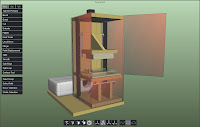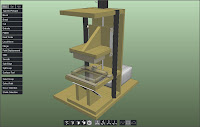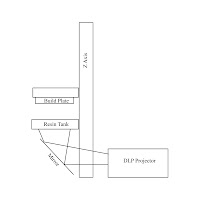Sunday, May 22, 2011
Size Does Matter!
Tuesday, May 17, 2011
It's mocking me!
 I've mocked up a quick 3d of my design concept. As I said before, I'm going to use easily obtainable budget priced components whenever possible. I plan to use MDF which I will seal with paint, glass, Plexiglas, aluminum and steel angle. I can get most of the construction materials from Home Depot or a local plastic supplier. I'll break down the materials as I build. I've started collecting what I'll need so I can begin building soon.
I've mocked up a quick 3d of my design concept. As I said before, I'm going to use easily obtainable budget priced components whenever possible. I plan to use MDF which I will seal with paint, glass, Plexiglas, aluminum and steel angle. I can get most of the construction materials from Home Depot or a local plastic supplier. I'll break down the materials as I build. I've started collecting what I'll need so I can begin building soon. Until then here are some more screen shots of the design. This was just a quick mock up so the sizes are approximate. I'll work out the exact dimensions as I build.
Until then here are some more screen shots of the design. This was just a quick mock up so the sizes are approximate. I'll work out the exact dimensions as I build. 
Here we go again
 Here is a quick sketch of the basic idea. As you can see it's a little different from the previously mentioned lesson plan. In the example in the lesson plan the image is projected on the surface of a tank (in that case a beaker) of resin and the part is submerged into the resin as it is solidified. A variation of this method is to expose the resin at the bottom of the tank to the UV and have it stick to a plate which is raised up out of the resin. Each new layer sticks to the previous one and is lifted upward. I chose a bottom up method because then I don't need a resin tank deep enough to contain my maximum z travel. Also the submersion tank method requires a large volume of resin from the start. A shallow tray only requires a small volume of resin be maintained (and possibly exposed to the degrading effects of unwanted UV and moisture). Also the Z build height will not be limited (theoretically) by a fixed tank depth or my financial ability to fill said tank. Most of the designs I have found in my research place the projector vertically directly under the resin tank. I am going to place the projector horizontally behind the z axis. Initially I plan to borrow a projector as I see this as being the single most expensive component. By placing it behind I can easily remove/replace the projector and also have much more flexibility over the focal distance. This also will keep the total height of the printer smaller. If I went all vertical the total height would probably end up close to 4 feet. Lastly, since the projector won't be mine (at least initially) I really want to protect it from any resin drips!
Here is a quick sketch of the basic idea. As you can see it's a little different from the previously mentioned lesson plan. In the example in the lesson plan the image is projected on the surface of a tank (in that case a beaker) of resin and the part is submerged into the resin as it is solidified. A variation of this method is to expose the resin at the bottom of the tank to the UV and have it stick to a plate which is raised up out of the resin. Each new layer sticks to the previous one and is lifted upward. I chose a bottom up method because then I don't need a resin tank deep enough to contain my maximum z travel. Also the submersion tank method requires a large volume of resin from the start. A shallow tray only requires a small volume of resin be maintained (and possibly exposed to the degrading effects of unwanted UV and moisture). Also the Z build height will not be limited (theoretically) by a fixed tank depth or my financial ability to fill said tank. Most of the designs I have found in my research place the projector vertically directly under the resin tank. I am going to place the projector horizontally behind the z axis. Initially I plan to borrow a projector as I see this as being the single most expensive component. By placing it behind I can easily remove/replace the projector and also have much more flexibility over the focal distance. This also will keep the total height of the printer smaller. If I went all vertical the total height would probably end up close to 4 feet. Lastly, since the projector won't be mine (at least initially) I really want to protect it from any resin drips!I'm going to try and keep this as simple (basic) as possible. I envision a build plate that is in a carrier so it can easily be removed when the print is done. Also the resin tank needs to be removable for easy cleaning. Then there is the matter of preventing the cured resin from sticking to the bottom of the tank. I think some combination of non stick surface and mechanical movement. As you can see it will be easy to get very complex. I'll have to resist the temptation to over engineer. I'm working on a more detailed design mock up that I'll have ready in a few days.
My goal is to create a 3D printer that can be built with readily available, easily fabricated and affordable components.
I hear you thinking..."He must be MAD! It just can't be done!"
Only time will tell.... Cue the manical laughter.
Monday, May 16, 2011
It's a Brand New Day....
https://www.nano-cemms.illinois.edu/media/content/teaching_mats/online/3d_printing/docs/guide.pdf
As you can see it's really not that complicated (mechanically at least). For this project I'm going to try to stick with 2 principles. Keep it simple and make it cheap! My intention is to build a functional 3d printer within my almost non-existent budget. Later, if successful and as finances allow, I can upgrade components to achieve higher precision.
I can break this project down into 3 parts:
1. Hardware
2. Software
3. Chemistry
I'm confident that I can build the hardware portion of the printer. It's actually much less complex than the inkjet/powder printer. In fact, I'm going to harvest much of what I need from that progect. I'm working on a design sketch which i'll post soon.
The software... well, I would love to be able to purchase comercial RP software (Magics 15) but there is no way that will ever happen. I think it's considered the gold standard because you need a pile of gold to buy it! It seems that any software that does everything I'll need (including generating support structures) falls into the catagory of "If you have to ask you can't afford it". Since I don't have access to a pile of gold, I'm going to make due with what I can afford (free) and what I already have (Powerpoint). I'll have to make due with manually adding support structures. I'm really hoping that the open source community will develop something for that.
Lastly, the chemistry. I'll worry about that after I get the hardware working. I see this as being alot like the ink/toner of 2d printers. The real money is in the consumables.
Now to sketch up some designs and start collecting materials.
Thursday, May 5, 2011
Stick a fork in it!
While I'm done with the powder based concept I have not lost my interest in developing an affordable 3d printer. And when I say affordable I mean one that I can afford (Meaning as cheep as possible). I'm really excited by some of the work being done on DLP 3d printers and have decided to shift directions and pursue this technology.
Check out what Junior Veloso is doing with his DLP printer!
http://3dhomemade.blogspot.com/
If that doesn't get you fired up then youre reading the wrong blog!
There's also an open source project by TJ Snyman that's in the development stage
http://tjsnyman.com/tjsnymanblogspot/?page_id=531
The good news is that I can cannibalize the powder printer for the electronics and mechanical stuff. Now to start gathering materials and start planning.
